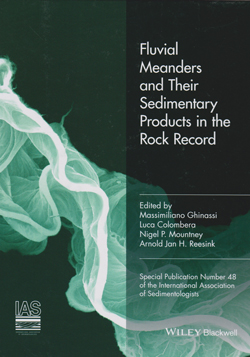
It is difficult to imagine a geoscientist who has not considered the nature of a meandering river, be it with a grain-size card and rock hammer, seismic data, or even clipboard and wellington boots. For many of us it will have been some time ago, and memories of secondary helical flow and lateral accretion surfaces may be rusty. This new volume provides an introduction to current ideas, a snapshot of active research, and pointers to future developments.
For example, it is now recognized that: (i) meandering rivers can migrate downstream as much as they migrate laterally, and that convex point bars may link to relatively mud-prone (concave) counterpoint bars as a result; (ii) mud-prone counterpoint bars and abandoned channel fills form stable buttresses against migrating channels and river patterns adjust accordingly; (iii) sandy meandering systems are likely to be common in the rock record, but can be difficult to distinguish from braided systems in the absence of rich palaeocurrent data or a clear view of plan form geometries; and (iv) not all river cut-offs are related to meander growth—some are caused by entrenchment of chute channels point across bars. Such insights are well-documented elsewhere in the sedimentological literature. This volume refines, reviews and extends them. As such it provides an excellent, high-quality resource for anyone new to the topic, and a benchmark for further detailed study of meandering river deposits
The volume is focused on fluvial meanders, but like the earlier and more general compilation SEPM 97 “From River to Rock Record” (2011), it brings together sedimentologists, geomorphologists, engineers, and workers from industry. The nineteen papers are largely based on outcrop fieldwork and satellite photo analysis of modern rivers, but include numerical simulations, electrical resistivity profiling, doppler current profiling, ground-penetrating-radar data, well data, seismic data and 3D models of ancient outcrops.
As for the active research, most of the papers address the facies architecture and shape of fluvial meanders. There is a snapshot of an ongoing debate on the evidence for pre-vegetation meandering rivers. Is plant stabilisation of river banks crucial for meandering patterns, and deep channels, or are they equally common in pre-Devonian rocks (they occur in modern unvegetated systems, and on extra-terrestrial surfaces)? The volume is strong in describing meander-bend cut-offs with: detailed analysis of the fill of abandoned sand-bed river channels; the first conceptual model of flow through neck cut-offs, and description of unsuccessful cut-off fills in ancient successions. There are also excellent insights in to how scroll-bar pattern variability can be used to predict lithological heterogeneity, and examples of mud-prone fluvial point-bar deposits.
The volume leans towards the zeitgeist in being relatively quantitative. Though not reaching the heights of “Big Data”, databases are used to place individual studies into context, and to derive general insights into the nature and controls on meandering systems. A gap, perhaps, is a modern exploration of the relationships between meandering channels and other river types, low-sinuosity, anastomosing and braided rivers, for example.
The editors point to paths for further research in the four main topics they recognise in the volume: channel-bend growth and related point-bar facies distribution; meander-bend cut-offs; meandering channels and vegetation cover; and geometries of meander belt sedimentary bodies. But most importantly they call for further work in unravelling the impact of man on meanders, noting a real need for “sedimentological models to assist with the management of rapidly evolving fluvial landscapes”.
Finally, the book is beautiful, particularly in its liberal use of coloured figures, and its technical content graces an already excellent series.
Reviewed by Tony Reynolds
FLUVIAL MEANDERS AND THEIR SEDIMENTARY RECORD, by Massimiliano Ghinassi, Luca Colombera , Nigel P. Mountney & Arnold Jan H. Reesink (Eds) 2019. Special Publication Number 48 of the International Association of Sedimentologists. Published by: WILEY Blackwell, 592pp. (hbk) ISBN: 978-1-119-42446-8
List Price: £ 75:00
W: https://www.wiley.com